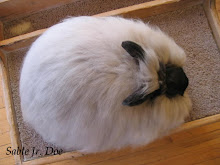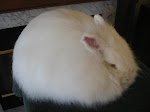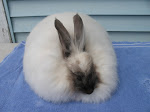
Bunny litters are born after a 31 day gestation period. At birth, the kits are approx. 2 inches long as well as naked and blind, but with daily feedings they begin to grow very quickly until their eyes open up around the 12th day, and they are climbing out of the nestbox by week 3:).
At about the same time as babies emerge from the box, they also begin to sample pellets and water, in addition to the hay and oats they have been munching in their nestboxes previously. Once they begin to eat solid food, it isn't long until they are eating alot of solid food, and in 2-3 weeks you are pouring pellets into food dishes around the clock, wondering how on earth so much food can disappear into so many little tummies, LOL. At this point, the kits are either weaning themselves or being weaned by mom (slowly), and by the 6-7th week they are ready to be separated from the doe entirely to begin an independent life.
When bunnies are initially weaned they are usually placed into a separate cage along with 1-2 other siblings of the same sex in order to minimize stress, and change is slowly introduced. At 9-10 weeks of age, angora babies are placed into their own cages to avoid ruining their growing coats, and they will live separately for the remainder of their lives with the exception of breeding and (in the case of does) raising litters.
At 12 weeks of age a growing rabbit begins to settle and hit adolescence. Weaned babies have established their own eating patterns and are beginning to fulfill their genetic potential, and this is also the time when differences in personality tend to emerge. Junior bucks are generally extremely "active" and somewhat on the hyper side (even more than somewhat in some cases, LOL), while does tend to be quieter at this age and much more relaxed.
At the 6 month mark, we find bunnies who have practically matured into adults, and a new set of behavior patterns surface. Physically, a 6 month old FA is nearly full grown (often weighing 8-9 lbs.), but many continue to hold onto their baby coats, though the first molt is probably right around the corner. At this point, the personalities of does and bucks tend to flip flop, and as the bucks quiet down and settle in, the does begin to get more and more antsy and temperamental. Hormonally, does are beginning to mature sexually which is something that has already occurred in the bucks (most bucks are ready to breed by 4 1/2 months), and along with the doe's development comes behavior such as cage territoriality, frequent digging and restlessness, and more of an "attitude" than you would encounter in a buck of the same age (so to speak:)). Not all does and bucks express these traits, but it is safe to say that most probably do. If the behaviors are indeed related to sexual maturity, then a breeder will find that they tend to slow down or be non-existent in off-times of the year such as winter, when breeding in the wild does not occur. Spring and Summer are prime breeding seasons with the most reproductive behavior taking place, while Fall and Winter show a marked decrease with considerably calmer and more tranquil bunnies:).
Later in life (2-3 years old or so), bucks often become extremely mellow, don't spray often (if they ever did to begin with), and are usually described as passive and calm. Does may continue to display breeding behaviors at certain times of the year, but they can mellow out quite a bit as well, in some cases becoming almost matronly:). Older does generally make wonderful mothers because of their experience and predictability at that age, and they are a pleasure to have around the rabbitry and on the showtable, where they have usually learned to sit very calmly in a picture perfect pose.
What most people normally think of as the ideal FA pet is a mellow older buck (older meaning anything over the age of 2). Does can make wonderful pets as well, but they tend to have different personalities due to their hormonal differences, and can be both terrible and entertaining depending on how you look at it:^). None of the personality traits listed above are carved in stone. There are certainly horrible bucks and fabulous does out there as most of us who breed can attest, but raising bunnies is also about genetics, and sometimes even the person who owns them and whether or not they "click" with the animal in question (we have all heard stories of bunnies who bit certain owners but loved other ones to death, LOL).
"Unpredictablility" is a term that will always apply to rabbits, no matter how we breed or raise them. One man's angel is another man's monster :^).
Hope you are enjoying the summer. I have been busy with birthdays, family reunions, and extra garden/bunny work, but it looks as though fall will soon arrive with angora-friendly weather (not that there's been anything to complain about the last few weeks in that department, however:)). Have a great weekend!























No comments:
Post a Comment